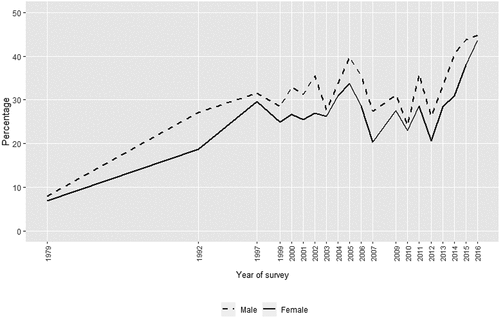ABSTRACT
The rise in support for Scottish independence between the 1970s and the 2010s has shaped Scottish politics and policy profoundly. The rise provokes a paradox: in this same period, the average educational level of people living in Scotland has also risen strongly, and yet, at each particular moment in time, higher levels of education have been associated with lower levels of support for independence. Scotland is an interesting case of wider developments. Recent political science theories of national populism in many countries would also lead us to expect that a movement for national sovereignty would be based mainly on the support of people with minimal education. Why both independence support and educational levels have risen is investigated using a series of 20 surveys of the Scottish population from 1979 to 2016. Using a long-time series allows the effects of survey year and birth cohort to be disentangled, and to be interpreted in the light of educational expansion since the middle of the twentieth century and also the different periods of political socialisation of successive cohorts.
Introduction
This paper considers the intersection of two long-term trends that are profoundly shaping Scottish society, and that are of interest well beyond that country. The most visible politically is the rise in support for Scottish independence, from fewer than one in 10 people in the 1970s to a quarter around the turn of the century, nearly a half in the referendum on the subject that was held in 2014, and over a half in many opinion polls since 2020. The other trend is common everywhere: the rising amounts of formal education across cohorts born between the beginning of the twentieth century and its last decade. The point of departure for the analysis in this paper is then a paradox arising from these two trends. Support for independence has been higher among people with minimal formal education than among people with advanced education. Support has also been higher among the young than the old. Yet the young have far greater amounts of formal education than the old.
Scotland is a potentially interesting case study of much wider developments, for three main reasons. The first is that Scottish nationalism may be interpreted as an instance of the growing political awareness of national sovereignty across Europe in recent decades, some of it – as in Scotland – expressed as a rebellion against the states that had been inherited from the middle of the twentieth century or earlier. The second reason is that the ideological basis of national assertion has varied among cases, even though most recent discussion has been of the politically right-of-centre kind, such as in Hungary and Poland. Scotland provides an instance of predominantly left-of-centre nationalism, in common with Wales, Catalonia, and also, outside Europe, recently in Quebec. Some instances of national assertion have had an ambiguous ideological basis, such as the campaign for the United Kingdom to leave the European Union, which, though predominantly on the right, has always had a significant element of support on the left. The fact that all these societies have seen a massive rise in educational participation since the middle of the twentieth century is the third reason. The Scottish case can be taken as a specific test of the common view (discussed in the next section) that recent versions of nationalism, interpreted as one kind of populism, have drawn their main support from people with minimal education.
The movement for Scottish independence may be traced back to the 1930s, with the founding of the Scottish National Party (SNP) in 1934. It was the sole credible political party of independence until the 1970s, and remains by far the dominant influence in the independence campaign (Mitchell, Bennie, and Johns Citation2012). The party had little sustained impact in the immediate post-war period, when the allegiance to Britain was strong, not only because of the experience of war but also because the welfare state was a common British undertaking that, it was widely felt, Scotland could not have afforded on its own. The SNP’s first sustained electoral impact was in the period when this post-war consensus began to break down, in the late-1960s and mid-1970s, prompting the UK Labour government of the 1970s to seek to set up an elected Scottish assembly with relatively weak powers. In a referendum of 1979, this was endorsed by 52% of those voting, but, because that did not reach the threshold of 40% of the whole Scottish electorate that had been stipulated by the UK parliament, the assembly was not established.
Nevertheless, the legacy of these 1970s debates led to growing support for some kind of elected assembly or parliament in the 1980s and 1990s (Brown, McCrone, and Paterson Citation1998). The support was partly based on nationalism, and always had some association with a sense of Scotland’s distinctive identity, but there was also a strengthening view that the case for devolution could be made on the grounds of good governance and of modernising UK democracy more generally (Keating Citation2010; Paterson Citation1998). There was a growing association of support for devolution with broadly left-wing political views on policy, partly because support for the UK Conservative Party steadily declined in Scotland even while the party remained dominant in the UK parliament. That contrast was influential in persuading the Labour Party to support devolution with few reservations. Following these ideological trends, and partly encouraging them, the SNP moved to the left (Jackson Citation2020). The UK Labour government elected in 1997 held a second referendum in 1997 on new proposals for a more powerful parliament than the assembly that had been proposed in 1979. The endorsement this time was strong, with 74% voting in favour. The parliament was first elected in 1999.
The first two devolved governments were coalitions of Labour and the centrist Liberal Democrats, but they were defeated in the 2007 election by the SNP. That party then won an absolute majority of seats in the 2011 election, an unusual achievement in a broadly proportional electoral system. The UK government of the time accepted that this was a mandate for a referendum on independence, which was held in September 2014. The SNP was the main proponent of independence in that campaign, but significant currents of support came from the Scottish Green Party and from an alliance of left-wing groups in the Radical Independence Campaign (Jackson Citation2020). This left-wing tenor of the campaign for independence was aided by the SNP government’s broad ideological position as social democratic (including on education: Arnott and Ozga Citation2016). The support for independence in the referendum was 45%, which, although short of a majority, was higher than in any survey up to the early summer of 2014. The SNP subsequently received the support of almost all of those who had voted for independence, allowing it to win almost all Scottish seats in the UK parliamentary election of 2015, and to win the Scottish parliament elections of 2016 and 2021. Independence support remained at the level achieved in the referendum, and slowly grew, partly in response to the result of the 2016 referendum on the UK’s membership of the European Union (EU), in which a UK majority of 52% voted to leave but a Scottish majority of 62% voted to stay. During the disruption caused by Covid-19 in 2020, most opinion polls gave independence a slight majority (What Scotland Thinks Citation2021).
The purpose of the present analysis is to understand how the changing levels of support for independence relate to the changing levels of education in the Scottish electorate over the long period from the time of the first referendum on a devolved assembly, in 1979, to the aftermath of the 2014 referendum on independence. In doing this, we distinguish between chronological time (1979–2016) and birth cohort (early 20th century to early-1990s), because the main influence on the amount of education which people have had is the period when they were born. Although the purpose of the analysis is not to investigate all the influences on independence support (for which see, for example, Scholes and Curtice Citation2020), we do also consider how the conclusions in relation to education are affected by the two influences that previous research has shown to be the strongest, personal national identity and expectations relating to the economic prospects of an independent Scotland. All the analysis is carried out separately for men and women, because women have historically had lower levels of support for independence and also, for people born in the 1960s and later, higher levels of educational attainment.
The paper is in four further parts. The next section sets the case of education and Scottish independence in the context of wider debates about education and attitudes to national sovereignty. The data and methods used in the analysis are described in the section after that, followed by the empirical results. The final section relates these findings to the wider debates.
Education and attitudes to national sovereignty
In recent academic writing, two dominant stories have been told about the relationship between education and liberal democracy. One blames educated elites for provoking nationalist rebellions against liberalism and globalisation. The other, in radical contrast, points to education’s encouragement for what are usually portrayed as the antithesis of these resentments: liberal tolerance, preference for international cooperation over national sovereignty, and distrust of nationalism. Neither of these stories fully describes recent Scottish experience of nationalism, and both raise some paradoxical questions about how to reconcile the growth in support for Scottish independence with the growth in levels of education.
One of the best-known pieces of evidence cited by the first story is a comment from the UK Cabinet Minister Michael Gove during the campaign that led to the referendum on the UK’s membership of the EU: ‘people in this country have had enough of experts from organisations with acronyms’ (Full Fact Citation2016). Often mis-quoted as being an attack on expertise per se, this actually more subtle point succinctly encapsulates a rebellion against the power exercised by highly educated elites in powerful institutions. The same sentiment can be found in academic analysis that is canonical in educational research, notably in the tradition of thought deriving from Bourdieu and Passeron (Citation1977, 123). Education, in this view, confers power through the habitus of the institutions where the highly educated work. Modern elites form increasingly closed cultural groups because of merit-selection, which has allegedly come to be a means by which advantage is reproduced rather than opened to wider social groups (Sandel Citation2020, 155–95; Wooldridge Citation2021, 306–28).
The disparate rebellions against this structure of power have been called ‘national populism’ by Eatwell and Goodwin (Citation2018, xxi-xxii), protests fuelled by a ‘distrust of politicians and institutions’, by relative social deprivation, by the loosening of ties to established political parties, and by a sense of the ‘destruction of the national group’s historic identity and established ways of life’. The most prominent instances internationally are the UK vote to leave the European Union, and the election of Donald Trump as president of the USA in 2016, but there are electorally strong instances also in France, Germany, Italy, Sweden, Hungary and Poland. Eatwell and Goodwin point out (25–27) that education is ‘one of major fault lines that runs beneath national populism across the West’, noting that, for example, in the 2016 EU referendum the ‘educational divide’ was greater than those by class, income, or age.
Other writers have made similar points. Goodhart (Citation2017, 23–24) describes the opponents of Brexit as being typically a ‘liberally-inclined graduate’. Curtice (Citation2017) noted that ‘support for Leave [in the 2016 referendum] and a hard Brexit is much higher amongst those with few, if any, educational qualifications than it is amongst university graduates’. Silver (Citation2016) and Mounk (Citation2018, 190) make similar points about the election of Donald Tump. Runciman (Citation2018, 164) sums up this interpretation in a way that takes us back to the habitus of elites: ‘the educated mistake their [own] tribalism for superior wisdom’.
Scottish nationalism might appear to offer a straightforward further instance of this first story. Goodhart (Citation2017, 53) draws the obvious parallel with Brexit:
Brexit was a movement to reclaim control/sovereignty from a supranational EU and the SNP is a movement to reclaim control/sovereignty from a multinational United Kingdom.
Although Eatwell and Goodwin (Citation2018, 79) distinguish between ‘populist nationalism’, in which they include the SNP, and ‘national populism’, the difference is a matter of emphasis rather than substance. Support for Scottish independence fits most authors’ definitions of populism. For example, Mudde and Kaltwasser (Citation2012, 8) define populism as ‘a confrontation between “the people” and “the establishment”’. In the Scottish case, this contrast is between the people of Scotland and the UK political establishment in London. That is why it seems reasonable for Norris and Inglehart (Citation2019: 486) to classify the SNP as a left-wing populist party.
Nevertheless, difficulties of classifying the Scottish case arise because the ideology of Scottish nationalism has generally been civic rather than ethnic (Jackson Citation2020; McCrone Citation1998). That then brings us to the second of the two academic stories about the relationship between education and democracy. This one is far older than the recent responses to populism, in some ways going right back to the eighteenth-century Enlightenment and including many of the nineteenth-century arguments for extending compulsory schooling as the necessary basis of extending the franchise. The ways in which education might support democracy were summed up by Lipset in 1960: education ‘broadens [citizens’] outlook, enables [them] to understand the need for norms of tolerance, restrains [them] from adhering to extremist doctrines, and increases [their] capacity to make rational electoral choices’ (quoted by Rindermann Citation2008, 308). Pinker (Citation2012) and Welzel (Citation2013)attribute the growth of peaceful civilisation to the extension of education. Education encourages critical thinking (Gutmann Citation1987), especially among adults (Egerton Citation2002; Bynner, Schuller, and Feinstein Citation2003) and independent ideas (Campbell Citation2006; Persson Citation2015; Rindermann Citation2008). It fosters liberal attitudes (Nie and Hillygus Citation2001; Stubagar, Citation2008; Surridge Citation2016; Van De Werfhorst and de Graaf Citation2004). It enables people to choose cultural allegiance, unconstrained by their social origins (Nieuwbeerta, de Graaf, and Ultee Citation2000; Paterson Citation2008).
Moreover, because nearly all citizens of the developed democracies now have at least a decade of schooling (up to mid-secondary school), and a majority have more than that, it is inaccurate to describe the ‘education divide’ as setting the uneducated against the educated. With the intellectual resources provided by education, those who rebel against elites, it may be argued, are perfectly capable of making that choice on the basis of educated rationality, a situation that, as Müller (Citation2016, 7–10) points out, is not adequately captured by the term ‘populism’. Curtice (Citation2014), indeed, has repeatedly shown that the two most powerful influences on people’s choice in 2014 were a combination of the affective and the rational: the power of one of these, national identity, may be thought to be consistent with the theories of national populism, but the influence of how people saw the economic prospects of an independent Scotland seemed the epitome of rational calculation.
This alternative view of the importance of rational evaluation of constitutional options has indeed been a strong current in Scottish nationalism, certainly in the long campaign for some kind of elected parliament when the case for devolution was made partly on the basis of liberal reform to the UK state (Paterson Citation1998). Because devolution quickly became the settled consensus after 1999, there did emerge a new political tension between the supporters of this new status quo – who were generally well-educated and well-connected – and the nationalist opposition that wanted to take the powers of the parliament further (McCrone Citation2019; Paterson Citation2009a). But the movement for Scottish independence, precisely because it had been on the left politically since the 1970s, has always had the capacity to attract to it the rebellious instincts of the young and educated (Jackson Citation2020). The prominence of young activists with university degrees was a widely noted feature of the campaigning for independence in the 2014 referendum (Crowther Citation2018; Paterson Citation2015). Moreover, whereas men had previously shown higher levels of support for independence than women (McCrone and Paterson Citation2002), there was some evidence that this sex difference may have weakened as independence support rose in the youngest cohorts.
Previous research has investigated the demographic and educational aspects of this change, but not linked them. The weakening statistical effects of education on support for independence has been noted by Merino (Citation2020) and by Eichhorn and Paterson (Citation2014), but without relating this to age (or, equivalently, to the cohort in which people received their main education). The importance of birth cohort in explaining support for independence has been analysed by Schneider (Citation2014), but without considering any possibly varying effects of education (and her analysis used data only up to 2012).
Thus for our analysis here there are three broad research questions, each of which we consider separately for men and women:
How has any association between education and support for independence changed over the four decades from 1979 to 2016?
How did any such changing association vary by birth cohort?
How did the relationship between education and support for independence vary according to national identity and to views about the economy of an independent Scotland?
Methods
Data
The data come from Scottish Social Attitudes Surveys and the Scottish Election Surveys. The attitudes survey has run almost every year from 1999, with the sole exception of 2008; we use 1999–2016. The target sample in each year was selected from the postcode address file and designed to be representative of all people eligible to vote. The election surveys were supplements to the British Election Surveys of 1997, 1992 and 1979, using the postcode address file for 1997 and the electoral register for 1992 and 1979. The designs were similar to those later used in the attitudes surveys. For all the surveys from 1997 onwards, the sampling used multi-stage clusters, stratified at the cluster level. All but the 1979 and 1992 data sets include weights in order to take account of the cluster sampling and to make the data representative with respect to sex and age. We use only respondents who were aged 25 or over at the date of survey, in order to have a reasonably complete estimate of their initial education.
The surveys were mainly funded by the UK Economic and Social Research Council, with further funding for specific modules of questions from the Scottish government and various research charities. The administration of the surveys by ScotCen Social Research, and by previous similar organisations, was wholly independent of the funders. Further details of all these surveys are in Curtice et al. (Citation2002: Appendix) and ScotCen (Citation2021). The data were obtained from the UK Data Archive.
The questionnaires were administered by interviewers in respondents’ homes, computer-aided from 1997. They covered the full range of topical political issues and also collected demographic information on respondents. We use six variables. Sex was recorded dichotomously in all surveys. The other variables are:
Birth cohort
In all but the 1979 survey, this is derived from respondent’s age at the time of the fieldwork; in 1979, it came from a question about year of birth. The cohorts, each a decade long (except the oldest and youngest), are shown in with a brief summary of the main educational and political contexts for respondents who grew up in the UK. From the surveys where a relevant question was asked (2006–14), at least 90% of respondents were indeed born in the UK; we retain in the analysis people who were not born in the UK because they were mostly eligible to vote in the 2014 referendum. Similar periods to define cohorts have been used in research by previous writers on the impact of educational change in the UK (for example, Iannelli and Paterson Citation2006).
Table 1. Salient educational and political experiences of the birth cohorts.
Education
This is the highest level of educational attainment at the survey date, shown in . For purposes of analysis, in order to have adequate sample sizes in small cells, the levels are grouped into three categories: higher education, full secondary education, and incomplete secondary education or lower. Cases with missing data on education are omitted from all the analysis (around 2% of cases in every year except 1979, when it was 4%).
Table 2. Highest educational attainment, by year of survey.
Support for Independence
In all the surveys, a question was asked about the respondent’s preferred constitutional arrangement. From 1997 to 2016, the offered categories were: independence outside the EU, independence in the EU, devolution with taxation powers, devolution without taxation powers, and no elected parliament. The 1992 wording options were similar, but omitting the distinction of devolution with and without taxation. For all these years, support for independence is defined here to be choosing one of the first two options. In 1979, only one independence option was offered, along with a parliament responsible for most Scottish affairs, an assembly responsible for some affairs, and no elected assembly. Independence support in 1979 is defined to be that unique option. This approach to defining support for independence is consistent with previous research (McCrone and Paterson Citation2002).
National identity
This has been asked about in a variety of ways, but the only reasonably consistent version that allows 1979 to be included is what has been called ‘forced choice national identity’: respondents were asked to choose the identity that best described them, from the list: British, Scottish, Welsh, Northern Irish, Irish, European, and Other. In every year, at least 88% of people chose either Scottish or British, and so we group this variable into these two categories and a category ‘other’.
Economic expectations of Independence
In 2013 and 2014 only, respondents were asked how independence would affect the Scottish economy, with a five-point response scale from ‘a lot better’ to ‘a lot worse’. Because this variable has been shown to have been strongly associated with voting for or against independence in the 2014 referendum, it is included in models restricted to these two years to assess how it interacts with education.
After the missing values on the education variable are omitted, the size of the samples used in the analysis are as shown in , a total of 25,128 respondents.
Statistical models
All the models are logistic regressions, in most of which the dependent variable is whether or not the respondent supported independence. One model also has the dependent variable as whether or not the respondent identifies as Scottish. The modelling was done in the statistical environment R, using the function ‘svyglm’ from the ‘survey’ package in order to be able to include the weights. The explanatory variables are sex, education, year of survey, birth cohort, and, where appropriate, national identity and economic expectations. These are entered as categorical variables, and as interactive effects among them.
For most purposes, the interactive affects are straightforward to include, but there is a complication for the interaction of year and cohort. Only the first four cohorts appear in all the surveys. Respondents in the two cohorts from 1957 to 1976 appear in all but the 1979 survey, because, in that year, even the oldest person from these cohorts (aged 22) did not reach the threshold of age 25. The 1977–86 cohort appears in 2002–16, and the 1987–91 cohort only in 2012–16. Therefore, to model the interactive effect of year and cohort, it was necessary explicitly to exclude terms that corresponded to empty cells in the full year-by-cohort table. For example, there was no term representing the interaction of the 1957–66 cohort and the year 1979. Thus, the total number of degrees of freedom for this interactive effect was 110, not 133 as it would have been if there were no empty cells. Using multiple cross-sectional surveys to disentangle the effects of survey year and birth cohort has been shown by previous researchers to clarify educational change over time (Breen et al. Citation2009; Ganzeboom and Treiman Citation1993).
The statistical effects of each term in the model are shown in summary tables in the online supplementary material. The main results are reported as predicted proportions supporting independence (or identifying as Scottish), mainly by means of graphs. In these graphs, as well as omitting the combinations of year and cohort that have been excluded from the models, we also omitted the two final years for the oldest cohort (born in 1926 or earlier), and the first year for each of the two youngest cohorts, because the sample numbers in these combinations of year and cohort were very small (20 or fewer). Where predictions are compared in the text, the appropriate standard errors are derived from the full covariance matrix of the predictions (‘vcov’ in R).
Analysis
The aim of the statistical analysis is to assess the competing claims which may be summed up thus:
is support for Scottish independence an instance of national populism, a rebellion against educated elites by people with little formal education and a strong attachment to national identity, especially older people?
or is independence support a rebellion by the young and educated, especially against a unionism that is associated with older generations who grew to maturity in the stable welfare state after the Second World War?
The surveys record the long-term growth in support for independence, which has been in two main phases, as shown in separately for men and women. The first was during the long period of Conservative government in the 1980s and 1990s, when support rose from one in ten to one in three. There was then broad stability after the setting up of the Scottish parliament in 1999, with brief spikes upwards when the SNP achieved an overall majority in the election of 2011, and also in 2004–5 in advance of their first electoral victory in 2007. The second sustained rise was around and after the 2014 referendum, reaching well over 40%.
At any particular point in time, moreover, independence support has been higher among younger people than among older. We investigate this more thoroughly below, but illustrates this gradient for the period around the referendum in 2014 (years 2013–16). It omits the oldest cohort (born before 1927) because its sample numbers in these years were very small. Even at the time of the referendum, independence support among people born before or around the Second World War is only a half that of people born in the last quarter of the century.
Figure 2. Percentage supporting Independence, by birth cohort and sex, restricted to survey years 2013–16.
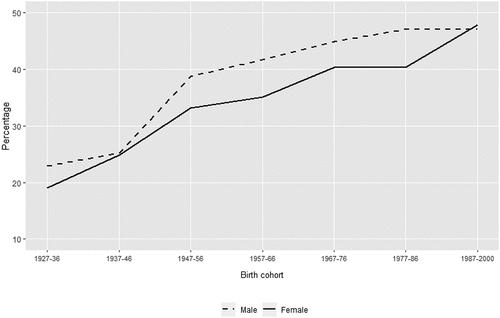
This same period also saw a large change in the distribution of educational attainment (). The most notable feature across the different surveys is the rise in the proportion with a higher-education qualification, from 9% in 1979, through 29% in 1999, 35% in 2009, to 40% in 2016. There was a large fall in the proportion with low or no formal attainment, from 53% in 1979 to 28% in 2016. These educational trends are even clearer when recorded by decade of birth. The proportion with a higher education qualification among the oldest cohorts is inflated by differential mortality (because people with high amounts of education tend to live longer). Nevertheless, even among surviving people in 2013–16, reflects the growth of education across the cohorts: higher education rises from 11% to 53%, and low or no formal attainment falls from 70% to 16%.
Table 3. Highest educational attainment, by birth cohort, restricted to survey years 2013–16.
The relationship of support for independence to education has changed over the surveys. The model is summarised in Table A1 (supplementary material), with predicted values in . Until about 2011, the proportion who support independence is lower among people with a higher-education qualification than in the other two categories. The evidence is not conclusive for 1979 and 1992 because the overall level of support for independence is quite low, but the difference among education categories then grew because independence support was unchanged or fell among people with higher education, while it rose in the other two education categories. Thus, on average in the period 1997–2003, for both men and women, independence support was 10 points higher among people with low or no attainment than among people with higher education (p < 0.001). The difference between secondary education and low or no attainment was 3.8 points (p = 0.04 for men and p = 0.02 for women). This average difference remained similar until 2011, despite the fluctuation upwards in 2005, but then there was convergence at a high level of independence support: from 2012 to 2016, the three education categories were separated by at most 2 points for both men and women (p > 0.3 for each comparison).
Figure 3. Predicted percentage supporting Independence, by year of survey, sex and education, 1979–2016.
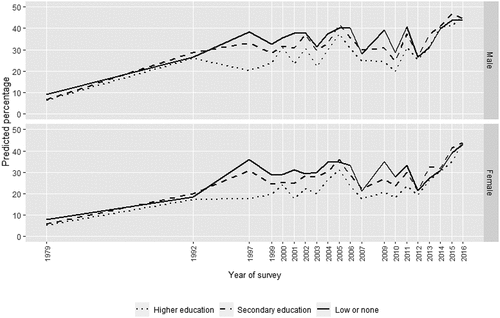
So, seems to show an unprecedented combination after 2012 of a high and growing level of support for independence with the end of any association between that support and educational attainment. There are two broad possible explanations here. One is generational replacement. Both independence support and educational attainment have risen across birth cohorts. So if the association of education with independence support is weaker in younger cohorts, then, as they have come gradually to be numerically dominant, so also will that association decline over the population as a whole. The other explanation would be simpler: after 2012, support for independence might have risen more rapidly among people with higher education regardless of when they were born.
To disentangle these effects, we model independence support in terms of year, birth cohort, sex and educational attainment. The summary is in Table A2 (supplementary material). There were broadly four types of pattern with respect to birth cohort, shown in the four pairs of graphs in . shows the two oldest cohorts (born up to 1926, and 1927–36). For both men and women, there was a rise in support for independence between 1979 and 1997 at all levels of education, but most sharply for people with low or no formal attainment. That pattern broadly persisted for the following decade, but then support declined, when the educational differences declined too. The pattern for these oldest cohorts at or around the referendum was thus barely different from the situation four decades earlier.
Figure 4. Predicted percentage supporting independence, by year of survey, sex, birth cohort, and education: birth cohorts -1926 and 1927–36
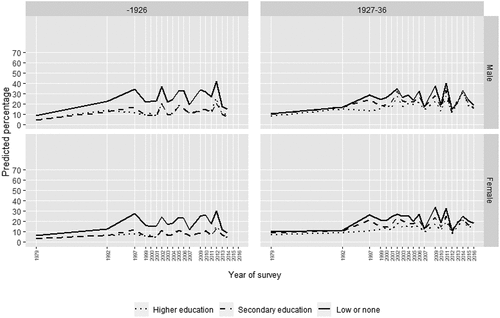
Figure 5. Predicted percentage supporting Independence, by year of survey, sex, birth cohort, and education: birth cohorts 1937–46 and 1947–56.
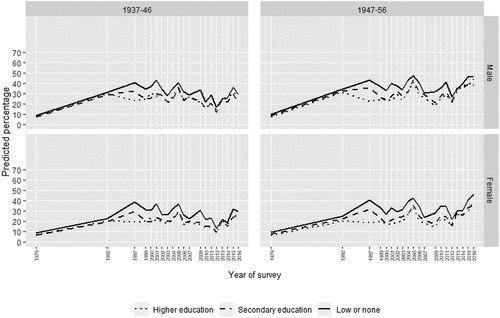
Figure 6. Predicted percentage supporting Independence, by year of survey, sex, birth cohort, and education: birth cohorts 1957–66 and 1967–76, and years 1992–2016.
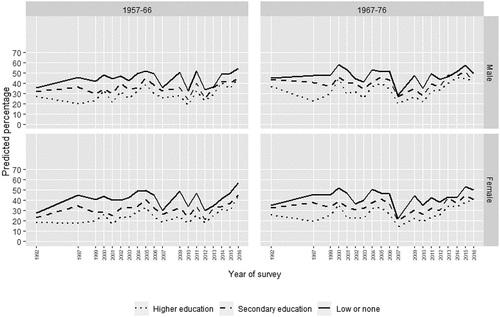
Figure 7. Predicted percentage supporting Independence, by year of survey, sex, birth cohort, and education: birth cohorts 1977–86 and 1987–91, and years 2003–16.
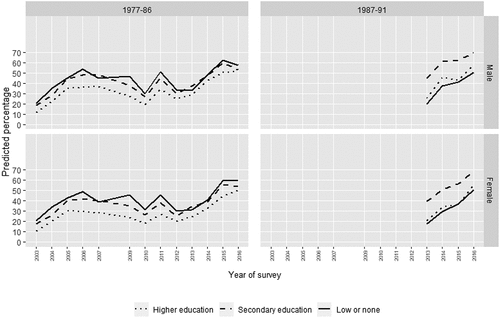
In contrast, in the graphs for all cohorts born from 1937 onward, there is a simple conclusion: there was a rise in support for independence at all levels of education. This rise is greater than any differences among cohorts in the association of independence with education. In these cohorts, the level of support in 2016 among people with higher education is at least as great as the support among people with low or no formal attainment in the 1990s. Indeed, for the two youngest cohorts, these graduates had higher levels of independence support in 2016 than was found amongst those with low or no formal attainment as recently as 2011.
The nuances of the graphs merely modify these broad trends. People born from 1937 to 1956, shown in , had a pattern similar to that shown in – a rise at all levels of education in the 1980s and 1990s, stable differences among the education categories from then till around 2011, and then a convergence of the education categories at and after the referendum. For people born from 1957 to 1976, the pattern from 1992 onwards is shown in : support was consistently high, and the education differences were stable. For example, for the cohort 1967–76, the difference in 2012–16 between the higher-education category and the category of low or no attainment was 8.7 points for men (p = 0.01) and 11 points for women (p < 0.001).
The youngest cohorts are shown in , starting at the first survey where reasonably large sample sizes were available for these cohorts. For all education categories, there was a rise to 50% or higher. In the youngest cohort, the category of secondary education overtook that of low or no education.
So the convergence of independence support among the education categories which was evident in is due to two different trends. One is indeed convergence within the four older cohorts – downwards for the oldest cohorts (born up to 1936), and upwards for the wartime and first post-war cohorts (1937–56). But there was no such educational convergence for the four younger cohorts (born from 1957 onwards): all education categories showed a rise. Because many more people in these younger cohorts (especially the very youngest) had higher education, the overall effect during the period 2013–16 was to shift the higher-education category in the population as a whole towards independence support.
The combined effect of these disparate cohort trends was that the educational basis of independence support rose over time. As late as 2004, more than 40% of independence supporters had low or no formal attainment and only a quarter had higher education. By 2014 and later, the position had reversed (respectively a quarter and over 40%). The graduates in 2016 were very much younger, coming from the independence-supporting generation: 32% had been born since 1977, and 58% since 1967, in contrast to only 6% and 32% in 2004.
A further clue to how this change in the educational basis of independence support came about is in the relationship of both of these variables to national identity. The statistical model which includes a measure of identity is summarised in Table A3 (supplementary material). For people with a Scottish identity, independence support around the time of the referendum was very similar in the different education categories, as shows for three selected cohorts. (It should be emphasised that the restriction to three cohorts is for purposes of illustration: the model included all cohorts.) This is true even for cohorts such as 1957–66 in this graph, where there were persistent differences with respect to education in . For example, in that cohort in the years 2013–16, the difference of independence support between women with a higher education and women with low or no formal attainment was 12 points in (not controlling for identity), but 7.9 points among people who called themselves Scottish (). Among men, the analogous differences were 10 and 3.2. For people with a British identity, by contrast, as well as independence support being generally at a lower level than among people with a Scottish identity, it was also lower among people with higher or secondary education than among people with low or no formal education, as shows for the same three selected cohorts.
Figure 8. Predicted percentage supporting Independence among people with Scottish identity, by year of survey, sex, birth cohort, and education: birth cohorts 1927–36, 1957–66, and 1977–86.
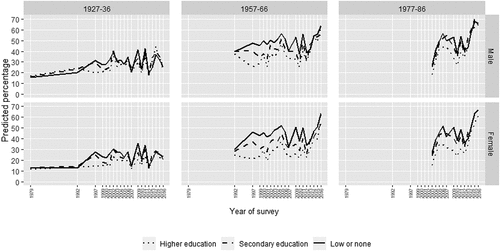
Figure 9. Predicted percentage supporting Independence among people with British identity, by year of survey, sex, birth cohort, and education: birth cohorts 1927–36, 1957–66, and 1977–86.
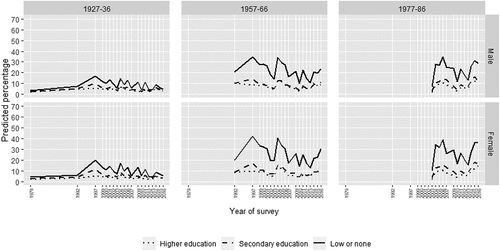
A partial explanation of these results for Scottish identity is that national identity is itself related to education. Consistently across the years, the proportion of people with a Scottish identity was somewhat lower among people whose attainment was higher; the educational gradient with respect to British identity was the reverse. But these education gradients did not change over time, and were never very strong (confirming a conclusion reached by Bechhofer and McCrone (Citation2009)). shows the pattern for Scottish identity with the same three selected cohorts as in (corresponding to the model in Table A4 (supplementary material)). Moreover, in the youngest cohort here the higher-education category no longer had the lowest proportion identifying as Scottish. The generally weak association of national identity with education has meant that having more graduates has not shifted identity away from Scottishness. One consequence of this is that a large part of the growth of support for independence is due to graduates who call themselves Scottish. Of all independence supporters in 2016, 32% were graduates with a Scottish identity, and this was larger than any of the other groups defined by attainment and identity: 28% were Scottish with secondary education, 23% were Scottish with low or no formal attainment, and the remaining 17% were from the other combinations of national identity and education. The percentage of independence supporters who were graduates with a Scottish identity was up from 23% a decade earlier, 12% in 1997, and a mere 7% in 1979.
Figure 10. Predicted percentage with Scottish identity, by year of survey, sex, birth cohort, and education: birth cohorts 1927–36, 1957–66, and 1977–86.
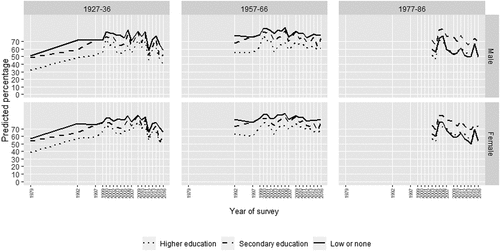
The previous research that was cited earlier found that, as well as national identity, the strongest predictor of voting for independence in the referendum was having a favourable view of an independent Scotland’s economic prospects. A question about that was asked in the surveys of 2013–14. However, this economic evaluation was only weakly related to education, and so the residual association with education after controlling for it was similar to that in . The details are shown in Table A6 and Figures A1 and A2 in the supplementary material. As with national identity, then, the importance of education is less than the influence of people’s beliefs.
In summary of the analysis, we can conclude that there is no clear evidence that people with low or no formal education were disproportionately likely to support independence in recent years as it has grown in popularity. In fact, that growth can be attributed in large part to graduates who identify as Scottish. Nor is the growth because of older cohorts, whether educated or not. In fact, some of the largest rise in support for independence was for people born in the 1950s and 1960s, the post-war cohorts. Younger cohorts had high levels of support from the time they reached voting age. Low-educated people in the cohort born before or around the war did show some increase in support in the 1990s, but this fell away when the campaigning for the 2014 referendum became salient, and graduates in these older cohorts always had low levels of support.
Some of the association with education is explained by national identity, which may thus be thought of as one way in which education is translated into views about independence. There were more young graduates than ever before, and, although they were no more likely than their predecessors to choose a Scottish identity, they were more likely to translate that into support for independence.
In short, if the movement for Scottish independence is a rebellion against elites, it is not based on the low-educated or the old.
Conclusions
The main strength of the analysis reported here has been the length of the time period it has covered, from the late-1970s to the period after the referendum on Scottish independence in 2014. This was a period of very great political change, with growing electoral divergence between Scotland and England, with the setting up of a powerful elected Scottish parliament, with the unprecedented growth of the main party supporting independence, and with support for independence itself rising from under one in ten to around one half, and well over a half of people born since the 1980s. The use of repeated surveys has allowed the disentangling of the effects of year and birth cohort. The same period and cohorts also recorded a transformation of educational attainment, with the proportion having a higher-education qualification rising from an elite of under 10% to nearly a majority in people born after the mid-1980s.
The main weakness is that there are no sources of data that track individuals over time. Our use of repeated birth cohorts over 20 surveys is only an approximation to that ideal design, and proper investigation of motives and beliefs would require a variety of methods to investigate life histories. We have also had to compromise on a rather general measure of educational attainment, recording level rather than content. In particular, it would be valuable to know whether there are differences in any educational effects on attitudes to independence between having studied social science or humanities on the one hand, or science and technology on the other. Previous research has shown that the propensity of education to foster democratic attitudes is stronger in the former than in the latter (Paterson Citation2009b). Moreover, despite using 20 surveys that include over 25,000 individuals, there is not enough data to break down the year-by-cohort-by-education interactive effect by further demographic characteristics such as social class, ethnicity, religion or region within Scotland.
Nevertheless, there was enough statistical power in the data to allow the varying effects of education to be traced over time and separately for women and men, enabling the analysis to offer some answers to the apparent paradox that we started with. Support for independence has risen even in a population where there has been an increase in the size of educated groups that, historically, have had least support for independence. Until the period around the referendum, there was a clear gradient of independence support across the educational categories, probably in fact widening in the first decade after the Scottish parliament was established in 1999. But from 2012, there was unprecedented narrowing.
Part of the explanation is the differences among birth cohorts. The oldest cohorts – born before the Second World War – never had high support. It was not negligible among low attainers in these cohorts, but even that died away as the referendum approached, falling to no more than about one in five. These are the cohorts who experienced the British solidarity of the war mostly as adolescents or adults, and who, as voters and workers, contributed to creating the welfare state. This point about the war cohorts has been made by many previous writers, but what we can now see is that their growing opposition to independence in 2014 was, compared to earlier, especially a matter of the low attainers among them, who were by far their majority.
The other cohorts all showed a rise in support for independence around the referendum, or the maintenance of an already high level of support. Support in the wartime and post-war generation (born 1937–56) moved upwards, at all levels of education, as the referendum approached. The next cohorts, born 1957–76, showed high support even in the 1990s, and remained there, but with little change in the educational differences. These cohorts’ first experience of politics was during the collapse of the post-war settlement in the 1970s and 1980s, and the growing alienation of the Scottish polity from the governments of Margaret Thatcher and John Major. But these cohorts were not young enough to experience mass higher education, and so some of the historical educational hierarchy of attitudes remained. Thus, by the referendum, although support for independence among higher-education graduates in these cohorts had reached 40%, that was still clearly less than among those with minimal education, where it was over 50%. That educational pattern changed clearly in the youngest cohorts, who were born mainly in the 1980s, and who came to political maturity after the Scottish parliament was established in 1999. The education gap was consistently smaller, and may have been reversed. Support among even those with higher education reached over 50%.
The main summary point about independence support at different levels of education is then that the overall convergence around the time of the referendum was mainly due to generational replacement – to the electorate’s gradually comprising more young people with more education who also were more likely than older cohorts to support independence. The only birth cohorts within which there was an upwards convergence among educational categories over time were those born in the third quarter of the twentieth century. There was also a convergence in people older than that, but it was downwards.
But that was not the whole story either, because the effect of national identity outweighed education. Among people with a Scottish identity, there was almost no educational effect at the time of the referendum. Holding a Scottish identity was high in all educational categories, even as higher education expanded. So, the demographic basis of independence support shifted to being predominantly graduates with a Scottish identity, who made up one-third of all independence supporters.
On the wider theories about national populism and attitudes to national sovereignty we can therefore say that they simply do not work for the case of Scotland. The education gap even as recently as the first decade of the present century might originally have suggested that these theories were relevant, but the gap has diminished as independence support has grown. Moreover, support for independence among the young is far greater than among the old, at all levels of education, in stark contrast to the support for Brexit in England. At these very different levels of overall support, the education gap in 2014 was low among both the young (born in the last quarter of the twentieth century) and the old (born before the war). Only for people born in the third quarter of the century was the education gap quite stable (), and so only for that specific generation does the theory of national populism have some persisting relevance, but, even there, this did not prevent graduates showing a steady rise in support from about 2010–12 onwards.
The Scottish case may thus show that general terms such as ‘populism’ are inadequate to explain attitudes to national sovereignty. In some countries, support for national sovereignty undoubtedly is associated with older people who have little formal education. But in Scotland the association has come to be almost the opposite, and allegiance to a national identity that has come to be felt to be in opposition to the existing state elites is common across all educational categories. The single word ‘populism’ does not capture this complexity.
Ethics statement
The paper is entirely based on secondary data. The participants in the survey gave their informed consent, as detailed in the original reports of the surveys noted in the Data and Methods section. The analysis on which the paper is based was given ethical clearance by the research ethics committee of the School of Social and Political Science, Edinburgh University, on 27 March 2017.
Supplemental Material
Download MS Word (70.6 KB)Disclosure statement
No potential conflict of interest was reported by the author(s).
Supplementary material
Supplemental data for this article can be accessed here
Additional information
Funding
References
- Arnott, M., and J. Ozga. 2016. “Education and Nationalism in Scotland: Governing a ‘Learning Nation’.” Oxford Review of Education 42 (3): 253–265. doi:10.1080/03054985.2016.1184865.
- Bechhofer, F., and D. McCrone. 2009. “Stating the Obvious: Ten Truths about National Identity.” Scottish Affairs 67 (First Serie (67): 7–22. doi:10.3366/scot.2009.0021.
- Bourdieu, P., and J-C. Passeron. 1977. Reproduction in Education, Society and Culture. London: Sage.
- Breen, R., R. Luijkx, W. Müller, and R. Pollak. 2009. “Nonpersistent Inequality in Educational Attainment: Evidence from Eight European Countries.” American Journal of Sociology 114 (5): 1475–1521. doi:10.1086/595951.
- Brown, A., D. McCrone, and L. Paterson. 1998. Politics and Society in Scotland. London: Macmillan.
- Bynner, J., T. Schuller, and L. Feinstein. 2003. “Wider Benefits of Education: Skills, Higher Education and Civic Engagement’.” Zeitschrift für Pädagogik 49 (3): 341–361.
- Campbell, D. E. (2006). “What Is Education’s Impact on Civic and Social Engagement?” Symposium on Social Outcomes of Learning (23-24 March 2006), Copenhagen: Danish University of Education.
- Crowther, J. 2018. “The Contradictions of Populism: Reasserting Adult Education for Democracy.” Andragoška Spoznanja 24 (1): 19–34. doi:10.4312/as.24.1.19-34.
- Curtice, J., D. McCrone, A. Park, and L. Paterson, eds. 2002. New Scotland, New Society? Edinburgh: Edinburgh University Press.
- Curtice, J. 2017. Why Did Brexit Not Work for the Conservatives? London: NatCen Social Research. Accessed 26 July 2021. http://www.natcen.ac.uk/blog/why-did-brexit-not-work-for-the-conservatives
- Curtice, J. 2014. “Independence Referendum: A Question of Identity, Economics or Equality?” In British Social Attitudes, edited by A. Park, C. Bryson, and J. Curtice, 1–19. London: NatCen Social Research.
- Eatwell, R., and M. Goodwin. 2018. National Populism: The Revolt against Liberal Democracy. London: Pelican.
- Egerton, M. 2002. “Higher Education and Civic Engagement.” The British Journal of Sociology 53 (4): 603–620. doi:10.1080/0007131022000021506.
- Eichhorn, J., and L. Paterson (2014). “Who Is Still Wavering? Turnout and the Undecided.” Edinburgh: ScotCen Social Research. https://www.ssa.natcen.ac.uk/read-the-reports/scottish-social-attitudes-2014/still-wavering.aspx (Accessed 26 July 2021
- Full Fact. 2016. “Has the Public Really Had Enough of Experts?“ Accessed 28 July 2021. https://fullfact.org/blog/2016/sep/has-public-really-had-enough-experts/
- Ganzeboom, H.B.G., and D.J. Treiman. 1993. “Preliminary Results on Educational Expansion and Educational Opportunity in Comparative Perspective.” In Solidarity of Generations, edited by H.A. Becker and P.L.J. Hermkens, 467–506. Amsterdam: Publishers.
- Goodhart, D. 2017. The Road to Somewhere. London: Hurst.
- Gutmann, A. 1987. Democratic Education. Princeton: Princeton University Press.
- Iannelli, C., and L. Paterson. 2006. “Social Mobility in Scotland since the Middle of the Twentieth Century.” The Sociological Review 54 (3): 520–545. doi:10.1111/j.1467-954X.2006.00628.x.
- Jackson, B. 2020. The Case for Scottish Independence. Cambridge: Cambridge University Press.
- Keating, M. 2010. Government of Scotland: Public Policy Making after Devolution. Edinburgh: Edinburgh University Press.
- McCrone, D., and L Paterson. 2002. “The Conundrum of Scottish Independence.” Scottish Affairs 40 (1): 54–75. doi:10.3366/scot.2002.0036.
- McCrone, D. 1998. The Sociology of Nationalism. London: Routledge.
- McCrone, D. 2019. “Peeble Them Wi’stanes: Twenty Years of the Scottish Parliament.” Scottish Affairs 28 (2): 125–151. doi:10.3366/scot.2019.0274.
- Merino, J.A. 2020. “The Rise of Independence Feelings in Catalonia and Scotland. A Longitudinal Study on the Profile of Independence in the Beginning of the 21st Century.” Review of Nationalities 10 (1): 1–19. doi:10.2478/pn-2020-0005.
- Mitchell, J., L. Bennie, and R. Johns. 2012. The Scottish National Party: Transition to Power. Oxford: Oxford University Press.
- Mounk, Y. 2018. The People Vs Democracy. Harvard: Harvard University Press.
- Mudde, C., and C.R. Kaltwasser. 2012. “Populism and (Liberal) Democracy: A Framework for Analysis.” In Populism in Europe and the Americas: Threat or Corrective for Democracy?, edited by C. Mudde and C.R. Kaltwasser, 1–26. Cambridge: Cambridge University Press.
- Müller, J-W. 2016. What Is Populism? Philadelphia: University of Pennsylvania Press.
- Nie, N., and D.S. Hillygus. 2001. “Education and Democratic Citizenship.” In Making Good Citizens, edited by D. Ravitch and J.P. Vitteriti, 30–57. New Haven: Yale University Press.
- Nieuwbeerta, P., N.D. de Graaf, and W. Ultee. 2000. “The Effects of Class Mobility on Class Voting in Post-War Western Industrialised Industrialized Countries.” European Sociological Review 16 (4): 327–348. doi:10.1093/esr/16.4.327.
- Norris, P., and R.F. Inglehart. 2019. Cultural Backlash: Trump, Brexit, and Authoritarian Populism. Cambridge: Cambridge University Press.
- Paterson, L., ed. 1998. A Diverse Assembly: The Debate on A Scottish Parliament. Edinburgh: Edinburgh University Press.
- Paterson, L. 2008. “Political Attitudes, Social Participation and Social Mobility: A Longitudinal Analysis.” The British Journal of Sociology 59 (3): 413–434. doi:10.1111/j.1468-4446.2008.00201.x.
- Paterson, L. 2009b. “Civic Values and the Subject Matter of Educational Courses.” Oxford Review of Education 35 (1): 81–98. doi:10.1080/03054980802351801.
- Paterson, L. 2015. “Utopian Pragmatism: Scotland’s Choice.” Scottish Affairs 24 (1): 22–46. doi:10.3366/scot.2015.0052.
- Paterson, L. 2009a. “Civil Society and the Parliament.” In The Scottish Parliament 1999-2009: The First Decade, edited by C. Jeffery and J. Mitchell, 113–118. London: Hansard Society.
- Persson, M. 2015. “Classroom Climate and Political Learning: Findings from a Swedish Panel Study and Comparative Data.” Political Psychology 36 (5): 587–601. doi:10.1111/pops.12179.
- Pinker, S.J. 2012. The Better Angels of Our Nature. London: Penguin.
- Rindermann, H. 2008. “Relevance of Education and Intelligence for the Political Development of Nations: Democracy, Rule of Law and Political Liberty.” Intelligence 36 (4): 306–322. doi:10.1016/j.intell.2007.09.003.
- Runciman, D. 2018. How Democracy Ends. London: Profile.
- Sandel, M. 2020. The Tyranny of Merit. London: Allen Lane.
- Schneider, A. 2014. “Age and Variations in the Attitude Towards Scottish Independence – An Exploration of Cohort and Lifecycle Explanations.” Scottish Affairs 23 (1): 55–78. doi:10.3366/scot.2014.0005.
- Scholes, A., and J. Curtice (2020). “The Changing Role of Identity and Values in Scotland’s Politics.” What Scotland Thinks. https://whatscotlandthinks.org/wp-content/uploads/2021/04/WST_The-Changing-Role-of-Identity-and-Values-in-Scotlands-Politics_v2.pdf (Accessed 27 July 2021
- ScotCen (2021). “Scottish Social Attitudes.” https://www.ssa.natcen.ac.uk/ (Accessed 27 July 2021
- Silver, N. 2016. “‘Education.” Not Income, Predicted Who Would Vote for Trump’ 28 (July): 2021. Accessed. http://fivethirtyeight.com/features/education-not-income-predicted-who-would-vote-for-trump/
- Stubager, R. 2008. “Education Effects on Authoritarian-libertarian Values: A Question of socialization.” British Journal of Sociology 59 (2): 327–350. doi:10.1111/j.1468-4446.2008.00196.x.
- Surridge, P. 2016. “Education and Liberalism: Pursuing the Link.” Oxford Review of Education 42 (2): 146–164. doi:10.1080/03054985.2016.1151408.
- Van De Werfhorst, H.G., and N.D. de Graaf. 2004. “The Sources of Political Orientations in Post-industrial Society: Social Class and Education Revisited’.” British Journal of Sociology 55 (2): 211–235. doi:10.1111/j.1468-4446.2004.00016.x.
- Welzel, C. 2013. Freedom Rising: Human Empowerment and the Quest for Emancipation. Cambridge: Cambridge University Press.
- What Scotland Thinks (2021). “How Would You Vote in a Scottish Independence Referendum if Held Now?” Edinburgh: ScotCen Social Research. https://whatscotlandthinks.org/questions/how-would-you-vote-in-the-in-a-scottish-independence-referendum-if-held-now-ask/ (Accessed 28 July 2021
- Wooldridge, A. 2021. The Aristocracy of Talent. London: Allen Lane.

